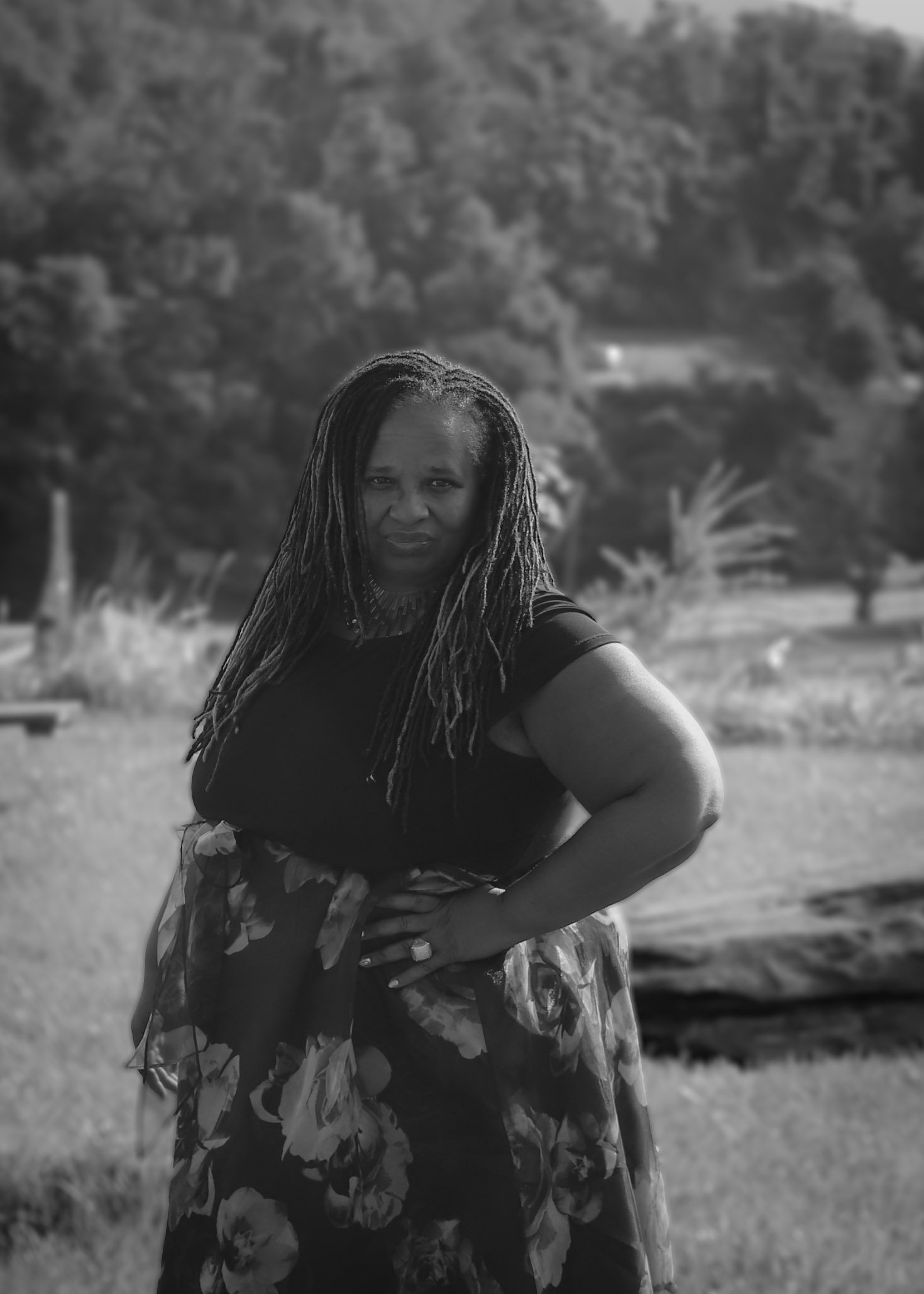7x7x7 Series: Lorie Strother
Lorie Strother is the seventh featured artist in our sixth 7x7x7 Series, which asks 7 questions to 7 Charlottesville artists and is published once a week for 7 weeks. Artist interviews and studio visits were conducted by our summer intern, Kalista Diamantopoulos. Photos in this interview were taken by Lindsey Leahy.
This summer's series is presented by The Seven Society and features artists affiliated with the University of Virginia.
A note about the photos: Working in Charlottesville and living in Waynesboro, Lorie often travels over Afton mountain. With this and the symbolism of the crossroads in Blues music in mind, Lorie asked that we meet at the top of Afton mountain where I-64, Rt. 250, and the Blue Ridge Parkway meet.
Intro written by Kalista Diamantopoulos. Published September 19, 2022.
As Blues-singer Lorie Strother makes her way back to her home in Waynesboro from her work in Charlottesville, she describes how Charlottesville was a place where she experienced many “firsts” in her musical career — her first gig at Dürty Nelly’s in 1999, her first photoshoot at U.Va. Darden.
However, her musical career took root long before she came to Charlottesville. According to Lorie, she came out of the chute singing, and has been singing since. And given her passion for singing, it was a natural choice for her to pursue an education in music.
Lorie learned about Blues music in a college class at the University of Massachusetts in Boston. Since then, she has strived to capture the Blues music that not many people have heard — particularly singers like Ma Rainey and Bessie Smith from the 1920s.
Lorie learned about Bessie Smith by listening to cassette tapes of her music in class — “Empty Bed Blues” part 1 and 2. Listening to Bessie Smith changed her perspective on the possibilities of Blues music. Lorie spent time trying to learn to sing like Bessie. She says it took living life and collecting experiences to achieve the grittiness in Bessie’s voice.
Currently, Lorie is working on her memoir which outlines her life from childhood to when she moved to Virginia — while also taking breaks, periods of rest to experience life. She hopes her memoir will be helpful to young people but at the very least it has been very cathartic for her to write. Everyone, she says, goes through different things in life, and once you come out the other end, those experiences become a part of you — a part of your character.
1. Describe what you are currently working on?
I’m currently working on writing a memoir spanning my childhood through early adulthood. I have a story to tell that serves as being cathartic for me while also being potentially helpful for others. I’m also working on the creation of beauty products which at the moment includes lip balms and whipped butters. While a memoir has been on my to-do horizon for a number of years now, the beauty products are relatively new as I worked to discover what my interests were in lieu of music given the adverse effects of COVID on my ability to publicly perform. I believe that I can do most anything that I put my mind to-these are the latest things.
2. What is your ideal creative environment?
My ideal creative environment could be any place with visual aesthetics and welcoming people creating a positive vibe. I also feel free to create when I am in nature with awesome views or the sights and sound of water. Beauty in any form has the ability to bring on my creativity.
3. How has Charlottesville impacted your artistic work and life as an artist?
Charlottesville has provided me with some memorable milestone artist experiences. My first ever photo shoot happened on Grounds at Darden. The photographer who worked with me at LexisNexis shared that he was an early photographer for the Dave Matthews Band-before the fame. That was enough for me to give him a try. I’ve had a number of photo shoots since then, but the black and white photos from that first shoot are still some of my very favorite photos today.
One of my first band performance experiences in Charlottesville was at Durty Nelly’s during the early 1990s. We played for four hours for the door. At the end of the evening, we received $25 which we split four ways! We were happy for the experience — the money — not so much.
As an artist it is always a pleasure to receive a standing ovation. Aside from the instant gratification that one feels, I consider it to be the highest honor that an audience can give to you in appreciation of your performance. I received my first ever standing ovation at the age of 9. I have received a few standing O’s since then including the one I received at Old Cabell Hall after performing the original song “Sing His Name”. I wrote “Sing His Name” after experiencing hurt, hopelessness, and anger, among other raw emotions, caused by the senseless murders of Alton Sterling, Philando Castile, and Heather Heyer.
On the evening of March 13, 2020, I was scheduled to perform at WTJU in front of a live studio audience. The performance would also be live streamed. However, because of the heightened COVID precautions that were enacted just a few days prior to our performance, the live audience was canceled. We went on to perform via live stream with only the sound man present. I had no idea at the time how that experience would be indicative of what many performing artists would have to do to sustain themselves artistically and financially during the pandemic.
4. What frustrates you as an artist?
At times, my inability to connect with my inner creativity can frustrate me. My observation is that this usually comes about when my actions and inner spirit aren’t jibing. For instance, if I sit down with the intent to create but I am not fully present because of some distraction within my spirit; then the creation is likely not going to happen. Thus, when there is misalignment-frustration can ensue.
5. How do you manage a work-life balance as an artist?
I instinctively want to be free to do whatever. However, to maintain somewhat of a balance I work to prioritize everything. Over time, I have also learned to slow down and rest when life requires it. This is a battle because I naturally want to keep going hard in the paint. I have come to appreciate that the rest of the mind, body, and spirit is an important part of the work-life balance recipe. This is especially important as I age and realize that I do not have the energy that I once used to. I’m not mourning for days of yore, I am simply accepting of who I am now in this moment and adapting accordingly.
6. Describe your favorite creative work by another Charlottesville artist?
I like the creative works of Lisa Woolfork. Specifically, her podcast Stitch Please and her sewing creations. I enjoy learning about the various artists that she brings to her show. I also love Lisa’s knack to share her intellect while simultaneously letting her personality and sense of humor shine through. While I have met Lisa a few times, I don’t know her personally. However, my intuition coupled with my experiences with her podcasts informs me that she is being her authentic self. This in of itself makes me appreciative of her work even more because of the complexities associated with authenticity of self for Black and Brown people as we navigate in the world.
7. How do your other interests influence your art?
Often, my other interests influence my art by offering me additional artistic opportunities. For instance, via my volunteer interests I sometimes will get an opportunity to do artistic work in that volunteer space. Thus, had I not taken up the other interest the artistic opportunity would likely not have come to fruition. Of course, there have been those times where other interests have interfered with my ability to create art. I am especially susceptible to this because I can find interest in almost anything. The key for me is to work to maintain a balance. I do that by involving myself in things that are most important to me. I want to say yes to so many things...but I have to say NO to things outside of my limited scope of artistic goals and personal interests or else I will not get anything done.
Lorie Strother, ‘The Dreaded BluesLady’ has performed her interpretation of Blues music since the 1990s. Lorie can’t remember a time when she wasn’t singing because it was something that came so naturally. However, she vividly remembers the moment when she decided that she would be a performer. That moment occurred when she received her first standing ovation at 9 years old. Since 2008, Lorie has performed with the Virginia based duo Dr. Levine and The Dreaded BluesLady. In 2012, the Virginia Foundation for the Humanities awarded Lorie an apprenticeship with Blues singer Gaye Adegbalola, formerly of the trio Saffire – The Uppity Blues Women. Lorie recalls it as a “great experience and a once in a lifetime opportunity to work with a blues legend.” Read more about Lorie here.
The opinions expressed in this interview are solely those of the artist and do not necessarily represent the policies or positions of NCAI.
This summer's series is presented by The Seven Society and features artists affiliated with the University of Virginia.





